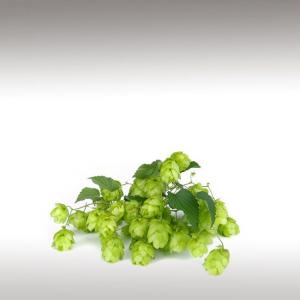
HOP CO2 EXTRACT (HUMULUS LUPULUS) - ESSENTIAL OILS

BASE / GENERAL DATA
Information submited: June 15, 2023 By: OperaDreamhouse
Botanical Name: Humulus Lupulus
Common Method of Extraction: CO2 supercritical extraction
Part Typically Used: Flowers / Stobiles
Color: Yellowish-brown
Consistency: Thick liquid
Perfumery Note: Middle
Strength of Initial Aroma: Strong, clear, crisp, pungent, green herbaceous, slightly citrusy
Self life: 6 years
The Hop plant is a perennial herb that grows in vines. Native to Europe, Western Asia, and North America, it is known for the speed and persistence of its growth. Most people are familiar with hops because of its role in beer-making, although it also featured in ancient kitchens and the medical recipes of herbalists.
Hops CO2 Extract Humulus (Humulus Lupulus) was discovered in the Middle Ages and from that time on became highly valued as a flavour and preservative in beer. First widely used in beer by monks in 9th- and 10th-century Germany.
The aroma of Hops is usually strong and pungent, but since this CO2 select extraction, the garlicky pugent notes softened and rounded out with clear and crisp green top notes. The middle herbaceous notes are freshened with lively citrus and a valerian - like back note. Fragrance connoisseurs will appreciate a sweet, fruty melion back note as well. In perfumery, Hops offers a bitter - green note that adds a unique dimension of uplifting brightness in pine, fougere, citrus (particulary lime).
Common Method of Extraction: CO2 supercritical extraction
Part Typically Used: Flowers / Stobiles
Color: Yellowish-brown
Consistency: Thick liquid
Perfumery Note: Middle
Strength of Initial Aroma: Strong, clear, crisp, pungent, green herbaceous, slightly citrusy
Self life: 6 years
The Hop plant is a perennial herb that grows in vines. Native to Europe, Western Asia, and North America, it is known for the speed and persistence of its growth. Most people are familiar with hops because of its role in beer-making, although it also featured in ancient kitchens and the medical recipes of herbalists.
Hops CO2 Extract Humulus (Humulus Lupulus) was discovered in the Middle Ages and from that time on became highly valued as a flavour and preservative in beer. First widely used in beer by monks in 9th- and 10th-century Germany.
The aroma of Hops is usually strong and pungent, but since this CO2 select extraction, the garlicky pugent notes softened and rounded out with clear and crisp green top notes. The middle herbaceous notes are freshened with lively citrus and a valerian - like back note. Fragrance connoisseurs will appreciate a sweet, fruty melion back note as well. In perfumery, Hops offers a bitter - green note that adds a unique dimension of uplifting brightness in pine, fougere, citrus (particulary lime).

SPIRITUAL PRACTISES DATA

MEDICINE / HEALTH DATA
Information submited: June 15, 2023 By: OperaDreamhouse
Hops CO2 Extract Humulus is recommended for use for its sedative and antibacterial, anti-inflammatory, antimicrobial, anti-oedematous and anti-cancer activity.
In Indian Ayurvedic medicine hops is recommended for its sedative and antibacterial activity. strong anti-inflammatory, antimicrobial, anti-oedematous and anti-cancer activity.
In Indian Ayurvedic medicine hops is recommended for its sedative and antibacterial activity. strong anti-inflammatory, antimicrobial, anti-oedematous and anti-cancer activity.

BEAUTY / COSMETICS DATA
Information submited: June 15, 2023 By: OperaDreamhouse
Hops CO2 Extract Humulus (Humulus Lupulus) good efficacy against gram-positive bacteria makes the hop extract especially suitable for deodorising soaps, shower gels, deodorising sticks and aerosol sprays as gram-positive bacteria are responsible for producing unpleasant body odours.

FOOD / COOKING DATA
COMMENTS
No comments.


